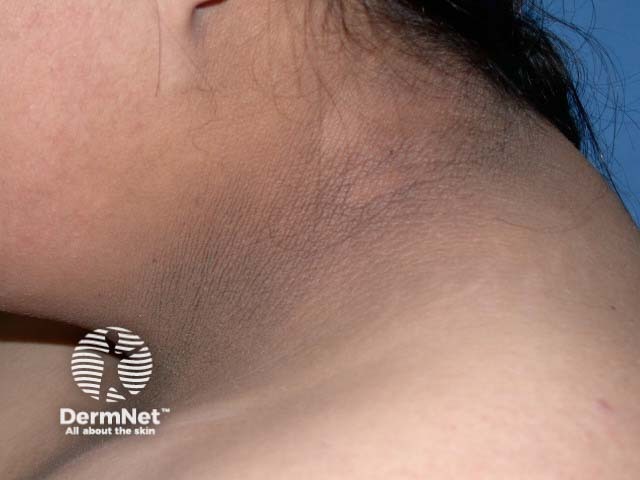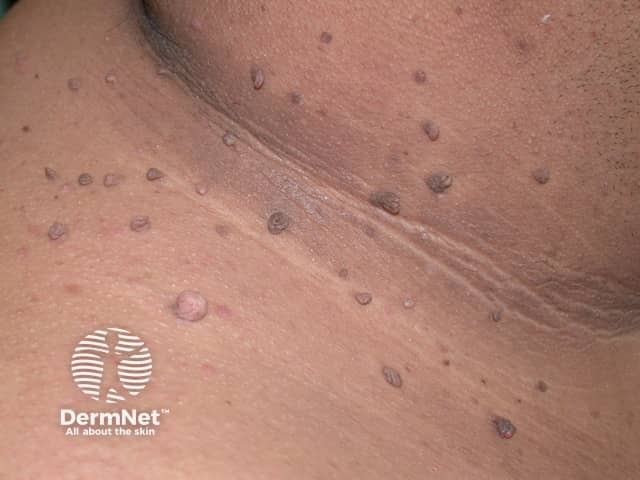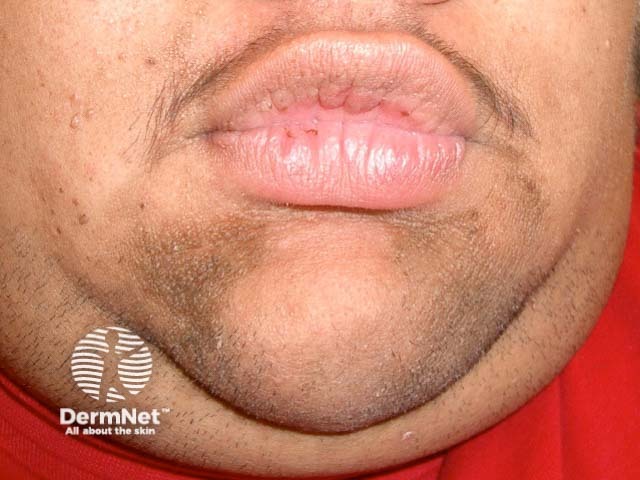Main menu
Common skin conditions

NEWS
Join DermNet PRO
Read more
Quick links
Insulin resistance — extra information
Insulin resistance
Author: Dr Nicholas De Rosa, unaccredited trainee in dermatology, Department of Dermatology, St Vincent’s Hospital Sydney, NSW, Australia. DermNet New Zealand Editor in Chief: Hon A/Prof Amanda Oakley, Dermatologist, Hamilton, New Zealand. July 2017. Copy Editors: Gus Mitchell/Maria McGivern. July 2017.
Introduction - insulin
Introduction - insulin resistance
Demographics
Causes
Clinical features
Complications
Diagnosis
Treatment
What is insulin?
Insulin is a polypeptide hormone that is produced by β cells of the pancreas and controls blood glucose (sugar) concentrations. High blood glucose concentrations stimulate the secretion of insulin, which transfers glucose from the bloodstream into muscle, fat and liver cells. This promotes the storage of glucose for future energy needs, and in healthy individuals, this feedback mechanism keeps the body at euglycaemia (average glucose concentrations).
What is insulin resistance?
Insulin resistance is defined as a subnormal glucose response to a given concentration of insulin.
- When there is resistance to endogenous (internally produced) insulin, blood glucose concentrations may be normal or high, while serum insulin concentrations are also high.
- Insulin-dependent diabetic patients may have resistance to exogenous (externally received) insulin. They require higher insulin doses than usual to manage high blood glucose (hyperglycaemia).
The natural progression of insulin resistance first involves hyperinsulinaemia (high levels of insulin) after meals and is later followed by fasting hyperinsulinaemia. The failure of compensatory mechanisms to maintain euglycaemia lead to hyperglycaemia, impaired glucose tolerance and diabetes mellitus.

Acanthosis nigricans

Skin tags

Acne, hirsutism + acanthosis nigricans
Who gets insulin resistance?
Insulin resistance is found in both men and women of all races and ethnicities. It is especially prevalent where people lead a sedentary lifestyle and consume a Western diet.
Causes of insulin resistance
Insulin resistance is influenced by a combination of genetic, epigenetic and environmental factors.
Inherited conditions
Insulin resistance can rarely be the result of inherited metabolic disease. These include:
- Insulin receptor mutations (such as leprechaunism)
- Type A syndrome of insulin resistance (insulin receptor mutations, signalling defects)
- Type B syndrome of insulin resistance (antibodies against insulin receptors)
- Decreased adiponectin and leptin associated with lipodystrophies.
Secondary insulin resistance
The majority of patients have secondary insulin resistance, which may be multifactorial.
- Obesity (70–80% of patients).
- Excess endogenous or exogenous hormones (systemic glucocorticoids, catecholamines, growth hormone, placental lactogen)
- Stress
- Infection
- Pregnancy
- Starvation
- Kidney disease
- Liver cirrhosis
- Ketoacidosis.
What are the clinical features of insulin resistance?
Insulin resistance is associated with a wide variety of clinical presentations. Factors to consider include:
- Obesity, particularly abdominal obesity: obesity can lead to insulin resistance through increased production of free fatty acids and adipocyte cytokines, which modulate insulin sensitivity and are pro-inflammatory.
- Abnormal glucose metabolism: this spectrum may range from hyperinsulinaemia with average glucose concentrations, to insulin-dependent type 2 diabetes mellitus requiring large doses of insulin to control blood glucose.
- Metabolic syndrome: the metabolic syndrome is the combination of obesity, hypertension, dyslipidaemia and hyperglycaemia.
- Hyperandrogenism and reproductive abnormalities: women with severe tissue resistance to insulin may present with virilisation, hirsutism, amenorrhoea or infertility often associated with polycystic ovarian syndrome.
- Musculoskeletal changes: some patients report muscle cramps unrelated to exercise.
- Autoimmunity: when insulin resistance is a consequence of autoantibodies, patients may also have other autoimmune disorders, such as systemic lupus erythematosus or systemic sclerosis.
Insulin resistance is thought to induce skin changes through hyperinsulinaemia, which activates insulin growth factor-1 (IGF-1) receptors in fibroblasts and keratinocytes and stimulates their proliferation. Hyperinsulinaemia can also influence sex steroid production and increase free testosterone.
What are the dermatological symptoms of insulin resistance?
The skin manifestations of insulin resistance can help to diagnose the condition and its complications. Skin manifestations can include:
- Acanthosis nigricans
- Acrochordons (skin tags)
- Acne
- Hirsutism
- Androgenetic alopecia (male pattern hair loss).
Skin diseases that have commonly been associated with insulin resistance and metabolic syndrome include:
What are the complications of insulin resistance?
The long-term consequences of insulin resistance include the effects of diabetes (eg, peripheral vascular disease, kidney disease, and visual complications) and certain malignancies associated with obesity and insulin resistance (eg, colon, breast, and endometrial cancers).
The hyperinsulinaemia, hyperglycaemia, and release of adipocyte cytokines associated with insulin resistance lead to vascular endothelial dysfunction, dyslipidaemia, hypertension, and vascular inflammation. These effects promote the development of the atherosclerotic cardiovascular disease.
How is insulin resistance diagnosed?
There is currently no validated test to measure insulin resistance in clinical practice, and the diagnosis is usually made clinically.
While the euglycaemic insulin clamp technique is the gold-standard technique to diagnose insulin resistance in the research setting, it is complicated, invasive and costly, and rarely used in clinical practice.
Blood tests in patients with insulin resistance may reveal:
- Elevated serum triglycerides (> 1.47 mmol/L)
- Elevated serum triglyceride, high-density lipoprotein (HDL) ratio (> 3.0)
- Elevated fasting insulin concentration (> 109 pmol/L).
The presence of obesity, hypertension, increased fasting glucose and triglyceride concentrations, and low HDL (high-density lipoprotein) is used to diagnose metabolic syndrome.
The diagnosis of polycystic ovarian syndrome may be supported by the detection of multiple ovarian cysts on pelvic ultrasound examination.
What is the treatment for insulin resistance?
There are no published guidelines on the management of insulin resistance per se.
Treatment that has been shown to decrease insulin resistance includes:
- Weight reduction
- Increased physical activity
- A Mediterranean diet, with an emphasis on fruits, vegetables, nuts and whole grains.
References
- Mantzoros C. Insulin resistance: definition and clinical spectrum. UpToDate. Updated 7 July 2015. (accessed 15 May 2017).
- Meigs J. The metabolic syndrome (insulin resistance syndrome or syndrome X). UpToDate. Updated 13 Jan 2017. (accessed 15 May 2017).
- Powers A. Diabetes mellitus: diagnosis, classification, and pathophysiology. In: Kasper D, Fauci A, Hauser S, Longo D, Jameson JL, Loscalzo J (eds). Harrison’s Principles of Internal Medicine. 19th edn. New York: McGraw Hill, 2015. Access Medicine. (accessed 14 August 2024).
- Eckel R. The metabolic syndrome. In: Kasper D, Fauci A, Hauser S, Longo D, Jameson JL, Loscalzo J (eds). Harrison’s principles of internal medicine. 19 edn. New York: McGraw Hill, 2015. PubMed (accessed 14 August 2024).
- Gonzalez-Saldivar G, Rodriguez-Gutierrez R, Ocampo-Candiani J, Gonzalez-Gonzalez JG, Gomez-Flores M. Skin manifestations of insulin resistance: from a biochemical stance to a clinical diagnosis and management. Dermatol ther. 2017;7:37–51. PubMed
- Napolitano M, Megna M, Monfrecola G. Insulin resistance and skin diseases. Scientific World Journal. 2015; 2015: 479354. PubMed
- Barbato MT, Criado PR, Silva AK, Averbeck E, Guerine MB, Sa NB. Association of acanthosis nigricans and skin tags with insulin resistance. An Bras Dermatol 2012;87:97–104. PubMed
- Gilkison C, Stuart CA. Assessment of patients with acanthosis nigricans skin lesion for hyperinsulinemia, insulin resistance and diabetes risk. Nurse Pract 1992;17(2) 26,8,37 passim. PubMed
On DermNet
Other websites
- Diabetes — Dietitians Association of Australia (DAA)
- Prediabetes & Insulin Resistance — National Institute of Diabetes and Digestive and Kidney Diseases
- Insulin Resistance — Medscape
